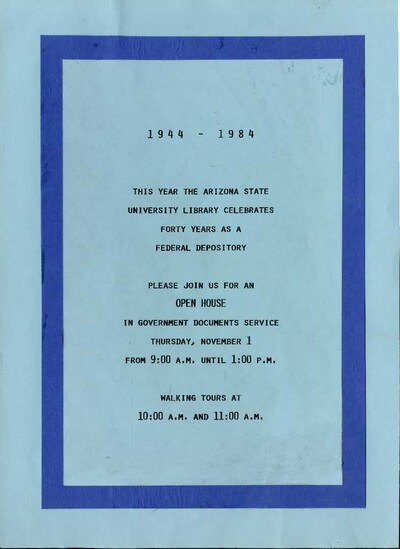In 1944, while the world was watching D-Day, President Franklin Roosevelt’s fourth-term election and the adoption of the G.I. Bill, Arizona State University (ASU) Library was also making history. The institution was known as the Arizona State Teachers College, and the library became a newly designated member of the Federal Depository Library Program (FDLP).

History of the FDLP
Established in 1895, the FDLP was created to ensure that information from all three branches of government was freely available to the American public. As part of the United States Government Publishing Office (GPO), the FDLP was initially composed of 420 designated depository libraries required to receive publications from GPO and make them accessible at no cost.
Since its establishment, the FDLP has grown to approximately 1,150 depository libraries throughout the United States and its territories. In Arizona, there are eleven federal depository libraries providing resources to communities statewide. Many types of government documents have been made available through the FDLP, including handbooks, manuals, reports and journals.
ASU Library and the FDLP: Then
In 1944, when ASU Library joined the FDLP, the primary format for government documents was print. Publications on topics such as World War II, atomic bombs and the Holocaust were among the variety of materials that were available to the library’s patrons. These documents were crucial for researchers because they offered valuable insight into current and historical events.

As the FDLP expanded over the decades, so did the volume and format of government publications. By the 1980s, microfiche had become a popular medium for distributing government publications, followed by CD-ROMs in the 1990s. During this era, water and mineral publications from the U.S. Geological Survey, technical reports from NASA, the Department of Defense and the Department of Energy, as well as environmental data from the Environmental Protection Agency, were used regularly by ASU Library patrons.
In the early 2000s, GPO began making government documents available online due to the rise of the internet. Accessing government documents became more accessible when GPO implemented an online public access catalog (OPAC) that included direct links to government documents. Publications on topics including the presidential election, Homeland Security, technology, the Iraq War and climate change would have been popular among researchers. Throughout these transitions, the FDLP continued to distribute print publications, maintaining a balance between traditional and new formats for sharing government information.



ASU Library and the FDLP: Now
For over 80 years, ASU Library has built an extensive collection of thousands of government publications that have benefited ASU students, faculty and staff, as well as members of the community.
Today, the Government Information Collection is housed at Fletcher Library on the West Valley campus and preserved at High Density Collections, and many publications are also available online. Students and researchers can access electronic government publications directly from the ASU Library online catalog. The collection spans a variety of subjects including military history, census data, Arizona history, legislative documents, taxes and National Parks. For more information about the collection, visit the Government Information Collection LibGuide or reach out to Ask a Librarian for help researching government documents.
Looking back, we celebrate ASU Library’s longstanding commitment to provide the ASU community with invaluable government resources, ensuring that these documents remain relevant and accessible to a new generation of researchers.
Happy 80th FDLP Anniversary, ASU Library!
-Brad Vogus, associate librarian, Social Sciences Division and FDLP Coordinator
-Janelle Nash, Government Information Collection Services supervisor